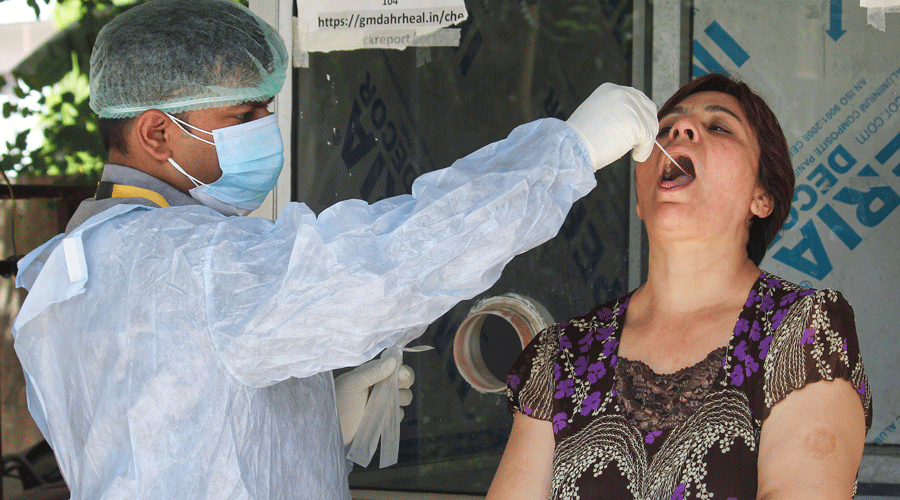How many people died of Covid-19 in India? Is it 521,965, the latest figure published by the government that it firmly insists is right? Or is it anywhere between 3 million and 5 million as calculated by half a dozen academic studies and on-the-ground reports that all reckon the government’s estimates are way below the real death toll?
A fierce battle over the actual death toll has erupted between the government and the World Health Organization (WHO) which leans toward accepting the higher numbers compiled by the private studies. The WHO wants to use those numbers in a study that looks at global mortality statistics. In reply to WHO, the government has issued a stout rejection of all the private studies, saying they used flawed methodology and assumptions to arrive at their conclusions.
“Five papers including our paper in Science (Magazine) places Covid mortality in India above 3 million,” says Chinmay Tumbe who’s a professor at IIM-Ahmedabad and author of The Age of Pandemics. He adds: “The lasting legacy of this administration is to live in total denial of India’s greatest demographic disaster since 1918.”
The government has slammed the private research efforts. “India’s basic objection has not been with the result (whatever they (sic) might have been) but rather the methodology adopted for the same,” the government said in a written response titled: “In response to New York Times article titled ‘India is Stalling the WHO’s Efforts to Make Global Covid Death Toll Public.’”
The fact, though, is that every in-depth academic study and reports by data journalists found that Covid-19 deaths were far higher than the government’s official figures.
5 studies, similar conclusion
Says virologist Shahid Jameel: “There are now at least five independent studies that all agree India’s figure to be about eight times the actual reported figure. That would place the number to be about 40 lakh or 4 million. These studies used different methodologies to reach the same average figure. These studies are all available in the public domain and open to scrutiny.”
Why does having an accurate death toll matter so greatly. Jameel says: “The most fundamental rule of (business) management is attributed to the guru of modern business management: Peter Drucker. It goes: If you can’t measure it, you can’t improve it.”
Jameel goes on to say: “Accurate estimates help build better models for the future and allow proper planning. If reliable estimates of infection and mortality were available after the 1st wave, it would have facilitated better planning for the Second Wave.” In addition, he adds: “How will India know in the future what worked, what didn’t and at what time in its Covid management, if its numbers are not accurate?”
UP may be the worst offender
Of the states which were reporting zero fatalities on certain days, India’s most populous state, Uttar Pradesh, may be the worst offender. Uttar Pradesh “has possibly been the one of the worst states in hiding data – either wilfully or due to sheer incompetence of its public health system,” said Jameel. During the pandemic peak several districts in the state were reporting zero fatalities.
Gujarat may also be among those states which have not been entirely open about its numbers. On-ground reports by newspapers like Dainik Bhaskar showed that in Gujarat the death toll was several times higher than official estimates. Dainik Bhaskar’s reporting team went district by district and combed through the civil registries where deaths are registered. It found that between March 1 and May 10, 2021, more than 1.23 lakh deaths had been certified compared to 58,000 during the same period the previous year. The state government’s figures showed only 4,218 deaths during this period.
One study has been by Prabhat Jha who led a team of researchers at University of Toronto. The study has calculated that at least 3.2 million people died. His team used three different methodologies to arrive at their numbers and each one arrived at roughly the same conclusions. Jha also teamed up with pollster C-Cover to carry out an online survey of households. Besides that, it studied government data of hospital deaths and also figures from the central registries in 10 states.
The study concluded: “COVID constituted 29 per cent of deaths from June 2020-July 2021, corresponding to 3.2M (3.1-3.4) deaths, of which 2.7M (2.6-2.9) occurred in April-July 2021 (when COVID doubled all-cause mortality).”
Deaths per million as in Brazil
“The actual numbers are at least three million or substantially higher than what has been officially reported,” Jha says. This would mean, he adds, that deaths per million were roughly around the same as in Latin America -- in countries, for instance, like Brazil. A large number of the deaths in this country took place in the April 2021-May 2021 period when the Delta virus was raging.
India’s official death toll would mean that deaths per million are considerably lower than in the United States.
Another study by Leffler, Lykins and Yang, published by medRxiv, which is a not-yet peer-reviewed or preprint service allowing investigators to share research, looked at the pandemic period up to August 2021 and concluded that excess deaths could be anywhere between 1.8 million and 2.63 million. The study used figures from the registry systems and looked at 17 states.
“The pandemic-related mortality through June 30, 2021 in 17 Indian states was estimated to be 132.9 to 194.4 per 100,000 population. If these rates apply to India as a whole, then between 1.80 to 2.63 million people may have perished in India as a result of the Covid-19 pandemic by June 30, 2021. This per-capita mortality rate is similar to that in the United States and many other regions.”
Among the most severely impacted
A further study by academic Murad Banaji and Aashish Gupta, also published in MedRxiv, concluded: “These data reveal that India is among the countries most severely impacted by the pandemic. It is likely that in absolute terms India has seen the highest number of pandemic excess deaths of any country in the world.”
“For the 12 states with available all-cause mortality data, we document an increase of 28 per cent in deaths during April 2020-May 2021 relative to expectations from 2019. This level of increase in mortality, if it applies nationally, would imply 2.8-2.9 million excess deaths,” the study found.
“More limited data from June 2021 increases national estimates of excess deaths during April 2020-June 2021 to 3.8 million. With more optimistic or pessimistic assumptions, excess deaths during this period could credibly lie between 2.8 million and 5.2 million,” the study added.
Chennai logs 41% excess deaths
On a different level, epidemiologist Ramanan Laxminarayan of the Washington-based Center for Disease Dynamics, Economics and Policy (CDDEP) conducted a study of the deaths in Chennai district, an area with good healthcare facilities. The study found that the number of deaths in the area “exceeded expected deaths by 25,990 and were 41 per cent about the normal death rate between March 1, 2020 and June 30, 2021.
Extrapolating from these numbers, Laxminarayan concluded that India could have seen upto 6 million deaths during the period. He pointed out that medical facilities in the Chennai district were far better than in many other parts of India but concedes this figure may be a big jump.
In a separate study looking at Madurai, Laxminarayan found that the city had only managed to capture about 1.4 per cent of all infections and concluded that India must have had a much larger number of cases than had been traced.
Strong objections
The government has raised strong objections to the independent studies and WHO’s calculations of around 4 million deaths. It maintains that the methodology used by the studies was not suitable for a large country like India where weather and other conditions vary widely.
Jameel notes that the government has only published an official death count “which we know is an underestimate in every country, not just in India. It is not possible to count every death during a pandemic for various reasons. In the end, the best estimates will come from multiple types of surveys that give an excess mortality figure.”
He says that by being tight-lipped about how it arrived at its figures, the government has sown doubts globally about the accuracy of its numbers. “The government has only criticised independent studies, but not put out its own estimates, despite an entire institute dedicated to epidemiology (NIE, Chennai; an ICMR institute),” he says. Critically, he adds that the government “continues to stonewall data available with MoHFW by not making it available to independent researchers. Lack of transparency breeds mistrust.”












